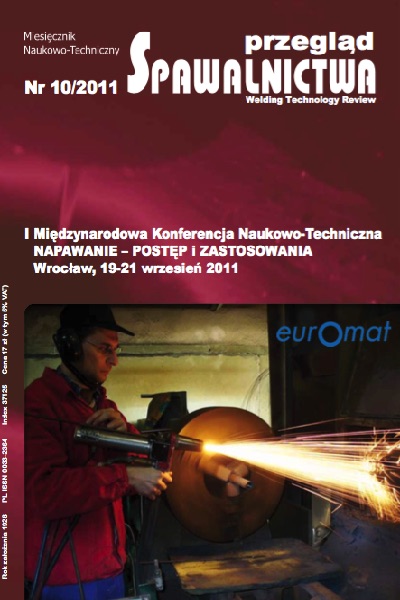Statystyczna ocena wpływu parametrów napawania ssa na geometrię napoin
Main Article Content
Abstract
W artykule omówiono problem określenia parametrów istotnych dla napawania drutem rdzeniowym samoosłonowym. Metoda SSA jest jedną ze spawalniczych metod, która daje duże możliwości w wytwarzaniu napoin o zróżnicowanym składzie chemicznym i dobrej jakości. Istotne jest określenie, które z parametrów napawania mają znaczący wpływ na właściwości napoiny. Zastosowanie planu Placketta-Burmana umożliwiło statystyczną ocenę istotności wpływu wybranych parametrów napawania na geometrię napoiny.
Statistic determination of self-shielded arc surfacing parameters influence on the padding welds geometry
In this work problem of determining of parameters for surfacing by using self-shielded arc is concerned. Self shielded arc surfacing (SSA) is one of the welding methods that gives big opportunities for producing cladding with wide range of chemical composition and good quality. The problem is to determine which parameters have the significant influence for producing cladding with defi- ned properties. Using Plackett-Burmans design gives opportunities to statistic evaluation of significant parameters on cladding properties especially its geometry.
Downloads
Article Details
Creative Commons CC BY 4.0 https://creativecommons.org/licenses/by/4.0/
Welding Technology Review (WTR) articles are published open access under a CC BY licence (Creative Commons Attribution 4.0 International licence). The CC BY licence is the most open licence available and considered the industry 'gold standard' for open access; it is also preferred by many funders. This licence allows readers to copy and redistribute the material in any medium or format, and to alter, transform, or build upon the material, including for commercial use, providing the original author is credited.
References
Klimpel A.: Napawanie i natryskiwanie cieplne technologie, WNT, Warszawa 2000.
Dziubiński J., Adamiec P.: Napawanie i natryskiwanie wczoraj i dziś, Przegląd Spawalnictwa, Nr 5/1998, s. 6-8.
Nowak A.: Napawanie blach Materiały XII międzynarodowej konferencji Spawanie w energetyce Turów 2000, Bogatynia 2000.
Dumowic M.: Repair and Maintenance Procedures for Heavy Machinery Components, Welding Innovation, Vol. XX No.1, 2003.
Hartung F.: Technologiczne i metalurgiczne kierunki rozwoju napawania żużlowego, Przegląd Spawalnictwa, Nr 1-2/1996, s. 7-10.
Pierlot C., Pawlowski L., Bigan M., Chagnon P.: Design of experiments in thermal spraying: A review, Surface & Coatings Technology 202, 2008, s. 44834490.
Arcondguy A., Gasgnier G., Montavon G., Pateyron B., Denoirjean A., Grimaud A., Huguet C.: Effects of spraying parameters onto flame-sprayed glaze coating structures, Surface & Coatings Technology 202, 2008, s. 44444448.
Frydrych D., Rogalski G.: Wpływ warunków spawania podwodnego metodą lokalnej komory suchej na zawartość wodoru dyfundującego w stopiwie, Pzregląd Spawalnictwa, Nr 11/2009, s. 29-34.
Kukiełka L.: Podstawy badań inżynierskich, PWN, Warszawa 2002.
